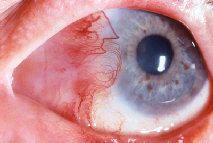Macular Degeneration
When tissue thins or deteriorates in the center of the retina, in an area known as the macula, the condition is called dry macular degeneration. Wet macular degeneration occurs when abnormal blood vessels leak under the macula causing it to become distorted. Both types degrade central vision.
Diabetic Retinopathy
In people with diabetes, abnormal blood vessels may develop and rupture in the viscous material that fills the back of the eye. The leaking of blood and fluid obscures vision.
Dry Eye
Dry eye is a condition that occurs when the eye does not produce the normal volume of lubricating tears. Symptoms include over-production of non-lubricating tears.
Flashes and Floaters
Flashes and floaters are shadows cast by tissue strands and clumps in the vitreous, the gel-like substance that fills the back of the eye. In youth, these objects are stationary. With age, the vitreous becomes more fluid and the strands and clumps begin to move around causing shadows on the retina.
Corneal Disease
Keratoconus is a weakening and thinning of the central cornea.
Fuchs’ endothelial dystrophy is an inherited abnormality of the endothelium, the inner cell layer of the cornea. A normal endothelium pumps fluids out of the cornea, keeping it clear. An abnormal endothelium causes swelling, leading to a cloudy cornea and decreased vision.
Bullous keratopathy is a condition in which the endothelium has been damaged and no longer pumps fluids out of the corneal tissue. The result is a permanently swollen cornea.
Corneal Abrasions
Corneal abrasions are scratches in the epithelium, the thin, outer layer of the cornea.
Corneal Ulcers
Corneal abrasions are sometimes deep enough to allow microorganisms to reach the layer beneath the epithelium, called the stroma and cause a corneal ulcer.
Pink Eye
Pink eye is also known as conjunctivitis and is the inflammation of the conjunctiva, the transparent membrane that lines the inside of the eyelid and the outside of the eye. Pink eye caused by bacteria is highly contagious.
Pterygium
A small fleshy growth can lead to chronic redness and irritation

Often related to sun and wind exposure and common in hispanics
The growths can be removed if growing, red or irritated despite conservative treatment (drops, avoidance of sun/wind)
The techniques vary and some are prone to higher recurrenc rates.
